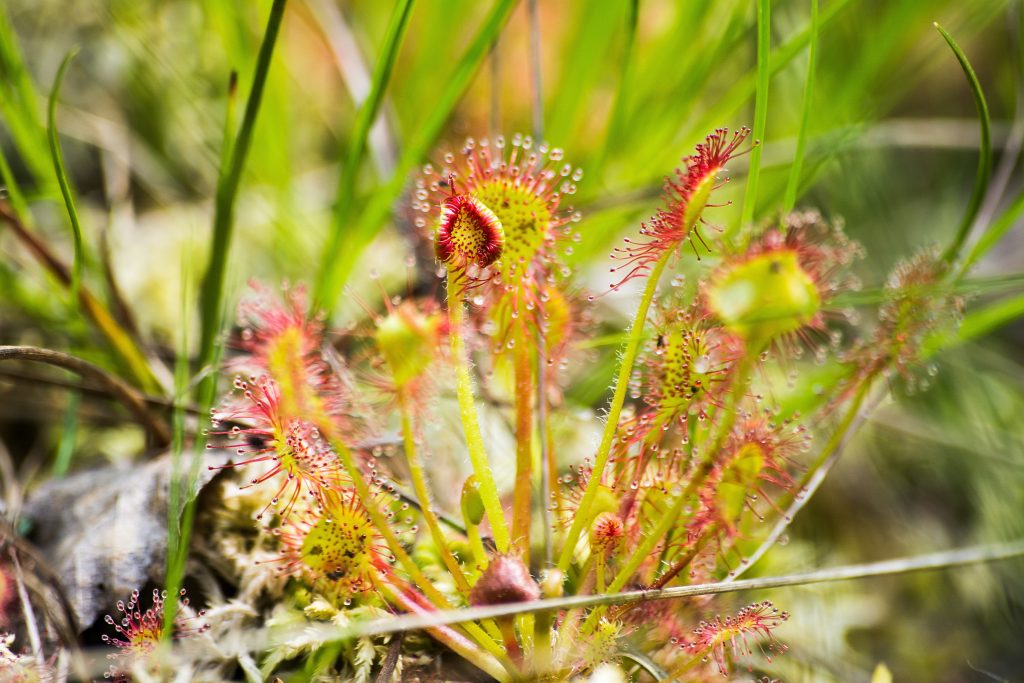Carnivorous plants are just as described- carnivorous. These plants seek nutrients from insects and small animals in the wild. Indoors, they rely on bugs like ants, flies, and spiders as they will not grow large enough to eat small animals. Carnivorous plants grow in bogs, or other environments where soil has poor nutrients. Because of this, they will not absorb nutrients through their roots, and rely fully on catching prey to eat. To catch their prey, all carnivorous plants have some sort of trapping mechanism- jaws set off by little hairs, a slippery basin filled with digestive liquid, or an incredibly sticky surface. These unique mechanisms help ensure their prey cannot escape once caught, allowing the plant to fully digest their prey. With over 750 species, carnivorous plants are on every continent except Antarctica, native to the Americas, Australia, and Southeast Asia. They come in a wide variety of shapes, colors, and textures. From the classic Venus Flytrap to beautiful pink and green Sundew, a carnivorous plant is a quirky and helpful addition to your houseplant collection! They are pet safe.
Almost all carnivorous plants prefer bright, indirect light.
These plants like their soil consistently moist at all times. Don’t let your carnivorous plant’s soil dry out more than 25% before watering, and never let it dry out completely. Water with distilled water, as tap water contains salts and chemicals that can harm the plant.
Ideal humidity varies between species, but carnivorous plants do best with humidity levels ranging from 50%- 90%. They are generally tolerant of temperature changes, with some species going dormant in the winter. Temperatures below 50 degrees or extreme heat can harm the plant.
Carnivorous plants can be propagated by taking cuttings of leaves/stems or by separation of pups from the mother plant. Depending on the species, one might be more successful than the other. Carnivorous plants can have shallow, fragile root systems, so be careful when separating a pup from the mother plant.
Carnivorous plants emit a wide variety of scents to lure prey. These scents are undetectable to humans. Baited by smells of nectar or the promise of a space to hide, bugs will travel to the plant.
While carnivorous plants can catch more than enough prey when in their native habitat, living indoors can be a different story. Despite this, your carnivorous plant will rarely die from not eating enough. Keep in mind, just because you don’t see your carnivorous plant eating doesn’t mean it is starving! It is possible the plant has eaten while you were at work or not looking. Despite this, if your plant is not catching any prey, it is more likely to stop growing then die entirely.
Never try to feed your carnivorous plant supplemental food. This means, don’t offer your Venus Flytrap a bite of your hamburger. Carnivorous plants will rot if given real food. If you stumble upon a dead bug of proportionate size, you can feed it to your plant, but sometimes you will need to set off its trapping mechanism. Venus Flytraps close when movement triggers the delicate hairs in its mouth. A dead fly isn’t going to set them off, so grab a toothpick and gently wiggle the hairs a little to help send signals to the traps that it’s time to eat!
Yes, and no. Each individual trap has a set number of times it will open/close to catch prey before it has expended all of its energy. The expended leaf/ trap will eventually dry up and die. This is why it’s extremely important to not try to set the traps off for fun. While it can be fun to watch the plant close its jaws, all you’re doing is making your plant miss out on possible nutritional opportunities. When the leaf dies without absorbing any nutrients, they won’t have the energy to grow a new leaf.
Ironically, yes. Carnivorous plants can get all of the same pests that normal plants can get. Most carnivorous plants are highly sensitive to pest removal chemicals, so we recommend going as simple and organic as possible. Most pests can be treated with a canola-oil-based treatment or diluted rubbing alcohol.
